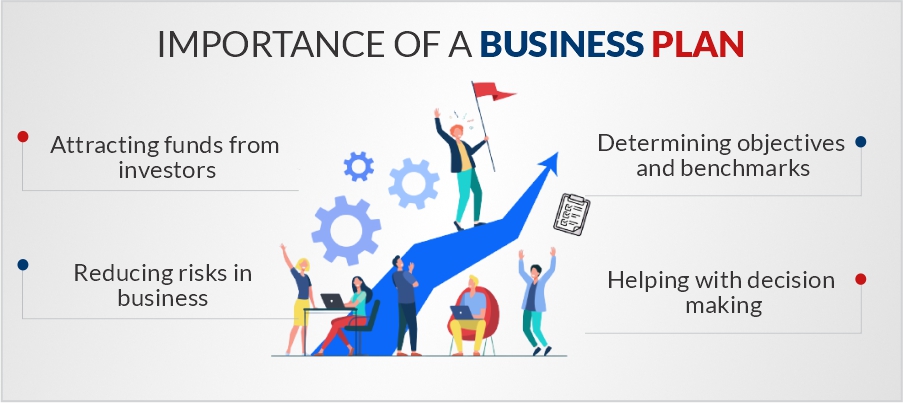Starting a business can be a journey that is both fun and hard. A business plan is an important tool that helps you stay organized, focused, and on track to reach your goals. A business plan is a written document that describes the goals, strategies, and financial projections of your business. It’s a plan for the future of your business.
In this blog, we’ll show you step-by-step how to make a simple business plan that will still work. We’ll also talk about how important it is to have a business plan, how to create one and give you tips on how to make your plan stand out. By following our simple step-by-step guide, you’ll be able to make a business plan that will help you get funding, bring in customers, and grow your business. Don’t forget to use our free business plan template to get started!
What is a Business Plan?
A business plan is a document that simply explains a company’s overall strategy, goals, and financial projections. It is also important to remember that a business plan is a living document that will be updated and improved as the business grows. This tool helps business owners and entrepreneurs clearly define their vision and goals and then come up with a plan for how to reach them.
It’s important to remember that a business plan isn’t just for new businesses. It’s also for established businesses that want to grow or move into new markets. A good business plan can help a company get money, attract investors, run well, and grow.
Importance of a Business Plan
1.Determining objectives and benchmarks
2.Helping with decision making
3.Attracting funds from investors
4.Reducing risks in business
What Does a Business Plan Include?
1.Subtitle
The subtitle is a short phrase or sentence that explains what the plan is about. It usually goes below the title of the business plan and is meant to get the reader’s attention.
2.Executive Summary
The executive summary is a short summary of the company, its products or services, and its goals. It is usually the first part of a business plan, and it should be written in a way that is clear, brief, and convincing. It shouldn’t be more than one or two pages long, and should include a summary of the plan’s most important points. This should be written after the rest of the plan is done and should give an overview of the plan’s most important parts.
An executive summary includes:
- Business name and location.
- Brief description of your products/services.
- Overview of financial projections and funding requirements.
- Key milestones or accomplishments.
3.Company Description
In a business plan, the section called “Company Description” talks about the company’s history, who owns it, and who runs it. It should tell people about the company, what it does, and where it wants to go in the future. This part of the document is important because it tells the reader about the company, what it does, and where it wants to go in the future. It should be written in a clear and concise way and give an overview of the company’s mission, legal structure, location, current operations, future plans, management team, advisors or board members, and history.
Basically a company description includes:
- Mission Statement: Explains the company’s purpose and values.
- Legal Structure: Describes if the business is a sole proprietorship, partnership, LLC, or corporation.
- Location: Shows the headquarters and any additional operational sites.
- History: Summarizes the journey so far, including key achievements or milestones.
- Management Team: Introduces key leaders, their roles, and expertise.
- Vision for the Future: Outlines long-term goals and aspirations.
4.Business Opportunity
In a business plan, the business opportunity section describes the problem or need that the company’s products or services will solve. It’s an important part that helps people understand why the company exists and what it wants to do. It’s important to remember that the business opportunity section of a business plan should be based on thorough market research and should be realistic and well thought out. It should give a clear and compelling picture of the problem or need that the company’s products or services will solve and how the company plans to take advantage of that opportunity.
5.Competitive Analysis
In the competitive analysis part of a business plan, the company’s competitors’ strengths and weaknesses are looked at in depth. This part helps readers understand where the company stands in the market and how it plans to compete with other businesses. Overall, the competitive analysis part of a business plan is important because it tells readers where the business stands in the market and how it plans to compete with other businesses. It should be written in a clear and concise way and give an overview of the company’s competitors, competitive environment, competitive advantage, SWOT analysis, and marketing strategy.
6.Target Market
The component of a business plan devoted to the target market offers an in-depth description of the type of clientele the company intends to attract, including demographics, psychographics, and purchasing patterns. This part is significant because it helps readers to get a feel of who the firm’s customers are and how the company aims to reach out to those customers.
7.Marketing Plan
In the marketing strategy portion of a business plan, the company defines the strategies and techniques it intends to utilize in order to reach its target market, as well as to meet the sales and revenue goals it has set for itself. It is essential to emphasize that the marketing strategy should be founded on exhaustive research of the target market, and that it should also be practical and well-thought-out. In addition to this, it should be in line with the overarching objectives and strategies of the organization, and it should include goals that are SMART, which stands for specific, measurable, attainable, relevant, and time-bound. In addition to that, it ought to include things like a budget and measurement strategies so that the marketing efforts may be monitored for their level of success.
8.Financial Summary
In the portion of a business plan titled “Financial Summary,” an executive summary of the company’s financial estimates and funding requirements is presented. This part is crucial because it helps to give readers a feel of the firm’s potential for financial success and how it plans to accomplish it, which is helpful in making informed decisions about the company. In general, the financial summary section of a business plan is a crucial component of the document because it gives readers an understanding of the company’s potential for financial success and the strategies it intends to implement in order to realize that potential.
9.Funding Requirements
The portion of a business plan titled “financing requirements” discusses the funding that the company will require to get its business off the ground and continue growing. This section is crucial because it helps give readers a feel of how much money the company will need to get started, and it also helps give readers a sense of where that money will come from. When viewed as a whole, the financial requirements section of a business plan is a crucial component of the document. This is because it gives readers an idea of how much money the firm will need to get started, as well as where that money will come from.
How to Write a Business Plan Step by Step?
1.Executive Summary
your business name, location, your mission and vision as a company, brief history, management and advisors information, products/services, industry/market, competitive advantages, and financial projections.
2.Company Description
For example: Consider answering these questions when writing the company description-
- Who is your target audience?
- What are your goals for your business and products/services?
- Where is your company located?
- When will you use your business plan and see results?
- Why should potential customers buy from you?
- How are you going to achieve the objectives you set for your business?
3.The Business Opportunity
You determine your Business Opportunity by responding to the following four questions:
- What is your source of income?
- Who are you selling to?
- What do you provide them?
4.Competitive Analysis
For example: Your report on competition analysis should consist of the following-
- Specifics on your goods/service in comparison to those of your rivals
- Price comparison
- Current and projected market share, sales, and revenues
- Variations in the ratings given by customers
- Marketing and social media strategy analysis
5.Market Research
For example: The following should be the order in which you conduct your market research:
- Create a buyer persona for your business.
- Find a persona group that you want to participate with.
- Create research questions for the people in your market study.
- Compile a list of your primary rivals.
- Provide a brief summary of your findings.
6.Description of organizational management
7.Product or service description
8.Marketing plan
- Mission statement
- Marketing objectives
- SWOT analysis
- Market research
- Market strategy
- Budget
9.Sales strategy
For example: Make sure you include the points mentioned below:
- Align with overall business objectives
- SWOT Analysis
- Customer strategy
- Set goals
10.Details on funding (or request for funding)
11.Financial projections
Simple Business Plan Writing Tips
1.Learn about your competition and audience
2.Show why you care
3.Provide supporting documents
You need to go back over your business plan and look for instances where you have referenced to studies, surveys, or comparisons so that you can figure out which additional documents you need to include.
4.Research a lot
5.Keep it simple
Business Plan Free Template Download
When you are enthusiastic about a new company or side project, it can be tempting to get immediately into the execution of the plan. However, making the effort to draft a business plan and put one’s ideas down on paper is extremely beneficial.
Looking for a fantastic customizable template to set the course for you? Smart Sales Kit has developed a carefully structured business plan template- and it’s free! Click here to download the free business plan template.






